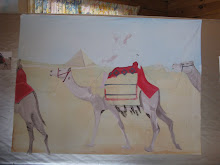Tuesday, July 20, 2010
Making Binding......Yuk!!
I am doing one of my least favorite sewing tasks, today. I am making the endless strip of black binding, which is what I most often use to finish my quilt edges. This is a tedious task, and I would much rather go on to a new project. I have explored other finishes, but I personally like the neatness of this edge. So, on and on I go, sewing this three inch strip, folding it in half, steam pressing it, then carefully laying it on and pinning to my quilt edge. I will sew it on, turn the edge and tonight while I watch TV, I'll do the other hated step.....hand sewing it all the way around. The reward here will be....another art quilt finished! Now to make the label!
Subscribe to:
Post Comments (Atom)


Have you tried putting the binding on by machine? I did one recently on my newest quilt and it turned out great. I copied it form Quilting ARts Mag. there are pictures if you want to check it out yourself.
ReplyDeleteGreetings !
In this issue of Quilting Arts Embellishments, Sarah Ann Smith shows you a quick and successful machine binding technique and we offer you more ways to learn stitching tips and techniques.
Back to Front Binding by Machine
By Sarah Ann Smith
Some quilts just ask for a lovingly hand-stitched binding, but other times it just isn’t necessary. The trouble with all-machine-sewn bindings, though, has been to get both sides to look good. My method will give you a professional finish on both the back and the front of your quilt.
The photo above shows examples of both zigzag stitching and blanket stitching. I used yellow thread, so you can see how the stitches rest on the sample, and matching blue thread, so you can see how the machine stitching disappears against the binding.
You can use straight-grain or bias bindings, butted-and-wrapped or mitered corners—it’s up to you. My articles in Quilting Arts issues 28 and 29 (Aug./Sept. and Oct./Nov. 2007) showed six ways to edge-finish a quilt; check out the first article for details on how to apply a front-to-back double-fold bias binding.
The twist here is that you first sew the binding to the back of your quilt and then wrap it to the front.
The key is to measure the binding carefully, and to understand that the front of the binding will finish 1/8" wider than the back. Here’s an example for a double-fold bias binding that finishes ¼"-wide on the back and 3/8"-wide on the front:
1/4" seam allowance plus 1/4" binding on back plus 1/8" for rolling around the edge plus 3/8" binding on front equals 1".
DOUBLE that amount for double-fold binding—in this case you will cut 2" strips.
Cut as many strips as you need to go around the quilt, plus plenty of extra for piecing and an 8" overlap.
Sew the strips together using diagonal seams.
Fold the strip in half lengthwise and sew it to the BACK of the quilt.
Wrap the strip around to the front so the binding is smooth and snuggles the edge of the quilt.
Pin, glue, tape, or fuse the binding to the front of the quilt to hold it in place.
Sew it down, removing pins/tape if appropriate.
The stitch you select is a matter of personal preference. I have used a zigzag, blind-hem stitch, and a blanket stitch for my quilts. You will be stitching in the ditch right next to the edge of the binding when the needle is on the left; the right-hand swing of the needle will capture the binding.
You can also use satin stitching with decorative thread for a mock-piping look.
This photo shows the back of the quilt. Because the front binding is wider than the back, all of the machine stitching falls onto the back of the quilt and makes for a neat, tidy finish. For the most invisible finish, use a thread that matches your backing fabric; here I used a contrasting thread for photo visibility in the center and a matching thread on the edges.